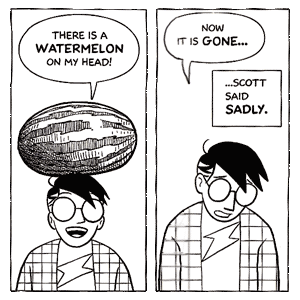
Then he moves on to choice of frame, which amounts to a complete course on composition and layout. McCloud, in the form of his own little talking cartoon man, takes you through all of this fluently. The idea is that from a plethora of possible moments, the cartoonist’s fundamental job is to select exactly the right moments to communicate the entire action. (You can make these flip-books on the corners of your textbooks during dull classes… but of course you wouldn’t) Then, from the 100 frames, I had students select the ten that summarized the entire action. They had a great time zipping through the hundred images and watching the auto-animated figure jump, cartwheel, run, or whatever.

Take the first one: I used to teach choice of moment by having students make a flip book in which a stick figure carried out some basic action over the course of 100 pages. There’s a choice of moment, choice of frame, choice of image, choice of word, and choice of flow.

McCloud starts at exactly the right place: with the five fundamental choices that a cartoonist has to make in order to set up any attempt at visual storytelling. McCloud’s new book is a 250-page text that brings together everything you need to know in one volume. I’ve taught cartooning before, and in order to give students anything instructional to study, I had to cut and paste from a lot of mediocre sources.

This one is a real how-to book, again in comic format. Last year McCloud followed up that excellent book with a new one, Making Comics: Storytelling Secrets of Comics, Manga, and Graphic Novels. But he wrote and drew a two-hundred page comic book about comics, and that made all the difference. If McCloud had written two hundred pages of critical prose on comics, it would have been well worth reading. Persuaded that the medium is the message, McCloud cast his encomium on comics in the perfect form: a comic. Intentionally echoing Marshall McCluhan’s title Understanding Media, McCloud’s 1993 book was a tour-de-force of critical insight. The best explanation ever written of the theoretical underpinnings of the comics medium is Scott McCloud’s Understanding Comics.

And if you’ve ever seen a real master of the craft lay down images one after another so that they move you through a mental progression, you know that comics do something unique. The one thing that comics can do that no other medium can do is put word and image together so tightly that they enter your mind as a unified whole. Good as the writing and art may be in a comic, we usually look for the highest achievements of word and image in other media.īut if you want word and image bundled together and doing things that they can’t do when they’re separated, comics are the only place to go. We don’t rely on comics for the best literary writing of all, and we don’t look to cartoonists to be the greatest visual artists. Essay / Art Making Comics with Scott McCloudĬartooning is an art form that communicates with great immediacy.


 0 kommentar(er)
0 kommentar(er)
